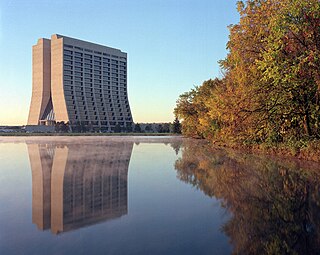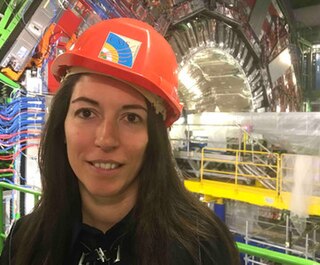
Fermi National Accelerator Laboratory (Fermilab), located in Batavia, Illinois, near Chicago, is a United States Department of Energy national laboratory specializing in high-energy particle physics.

The Compact Muon Solenoid (CMS) experiment is one of two large general-purpose particle physics detectors built on the Large Hadron Collider (LHC) at CERN in Switzerland and France. The goal of the CMS experiment is to investigate a wide range of physics, including the search for the Higgs boson, extra dimensions, and particles that could make up dark matter.

ATLAS is the largest general-purpose particle detector experiment at the Large Hadron Collider (LHC), a particle accelerator at CERN in Switzerland. The experiment is designed to take advantage of the unprecedented energy available at the LHC and observe phenomena that involve highly massive particles which were not observable using earlier lower-energy accelerators. ATLAS was one of the two LHC experiments involved in the discovery of the Higgs boson in July 2012. It was also designed to search for evidence of theories of particle physics beyond the Standard Model.

The Collider Detector at Fermilab (CDF) experimental collaboration studies high energy particle collisions from the Tevatron, the world's former highest-energy particle accelerator. The goal is to discover the identity and properties of the particles that make up the universe and to understand the forces and interactions between those particles.

ALICE is one of nine detector experiments at the Large Hadron Collider at CERN. The experiment is designed to study the conditions that are thought to have existed immediately after the Big Bang by measuring properties of quark-gluon plasma.

The DØ experiment was a worldwide collaboration of scientists conducting research on the fundamental nature of matter. DØ was one of two major experiments located at the Tevatron Collider at Fermilab in Batavia, Illinois. The Tevatron was the world's highest-energy accelerator from 1983 until 2009, when its energy was surpassed by the Large Hadron Collider. The DØ experiment stopped taking data in 2011, when the Tevatron shut down, but data analysis is still ongoing. The DØ detector is preserved in Fermilab's DØ Assembly Building as part of a historical exhibit for public tours.

Nigel Stuart Lockyer is a British-American experimental particle physicist. He is the current director of the Cornell Laboratory for Accelerator-based ScienceS and Education (CLASSE) as of May 1, 2023. He was the Director of the Fermi National Accelerator Laboratory (Fermilab), in Batavia, Illinois, the leading particle physics laboratory in the United States, from September 2013 to April 2022.
Hafeez Hoorani or Hafeez-ur-Rehman Hoorani or Hafeez R. Hoorani is a Pakistani particle physicist, with a specialisation in accelerator physics, and a research scientist at the CERN. Hoorani is working at the National Center for Physics, with research focus in elementary particle physics and high energy physics. Until the end of 2013, he served as scientific director of International Centre for Synchrotron-Light for Experimental Science Applications in the Middle East (SESAME) and is now research associate at the National Center for Nuclear Physics, Islamabad.

Don Lincoln is an American physicist, author, host of the YouTube channel Fermilab, and science communicator. He conducts research in particle physics at Fermi National Accelerator Laboratory, and was an adjunct professor of physics at the University of Notre Dame, although he is no longer affiliated with the university. He received a Ph.D. in experimental particle physics from Rice University in 1994. In 1995, he was a co-discoverer of the top quark. He has co-authored hundreds of research papers, and more recently, was a member of the team that discovered the Higgs boson in 2012.
Joseph Incandela is an American particle physicist, a professor of physics at the University of California, Santa Barbara and currently based at CERN, where he spent two years as the spokesperson for the Compact Muon Solenoid experiment at the Large Hadron Collider.

Yaşar Önel is a Turkish-born physicist who holds Swiss and American citizenship. He received his Ph.D. in Physics from London University in 1975. He worked at the Queen Mary University of London in the United Kingdom, and Neuchatel and Geneva Universities in Switzerland before joining the University of Texas at Austin in 1986. Then, he moved to the University of Iowa in 1988. He is a tenured faculty professor. of Physics at the University of Iowa in Iowa City, IA, USA.

Herman Brenner White is an American physicist who works at Fermilab. He won the 2010 American Physical Society Edward A Bouchet Award.

]
Paraskevas Andreas Sphicas is a particle physicist who focuses on studies of High energy collisions in the Large Hadron Collider through which he explores supersymmetry and the mechanism of spontaneous symmetry breaking. He is a senior scientist at CERN and professor of physics at the National and Kapodistrian University of Athens. He was elected a Fellow of the Royal Society (FRS) in 2019.
Tulika Bose is a professor of physics at the University of Wisconsin-Madison, whose research focuses on developing triggers for experimental searches of new phenomena in high energy physics. Bose is a leader within the Compact Muon Solenoid (CMS) experiment, a CERN collaboration famous for its experimental observation of the Higgs boson in 2012.

Bradley Cox is an American physicist, academic and researcher. He is a Professor of Physics and the founder of the High Energy Physics Group at the University of Virginia.

Meenakshi Narain was an Indian-born American experimental physicist. She was a Professor of Physics and Chair of the Department of Physics at Brown University, and was also Chair of the Collaboration Board of U.S. institutions in the Compact Muon Solenoid (CMS) Collaboration. She contributed to the discovery of the top quark in 1995 and Higgs Boson in 2012.

Florencia Canelli is since 2021 the appointed Swiss scientific delegate to the CERN council, the supreme decision-making authority of the CERN Organization. From 2021-2024, she was appointed chair of the IUPAP division of particles and field (C11). From 2021-2023, she was co-coordinator of the physics program of the CMS collaboration, a CERN experiment with over 3000 physicists. In 2010, Canelli was awarded the IUPAP Young scientist prize, an international prize awarded to one experimental and one theoretical physicist per year, for "her pioneering contribution to the identification and precision measurements of rare phenomenon through the use of advanced analysis techniques to separate very small signals from large background processes at the Tevatron collider." She has been an author on four multi-purpose collider experiments, namely the CMS experiment and ATLAS experiment at the CERN LHC, and the CDF experiment and D0 experiment at the Fermilab Tevatron. She is currently a full professor at the University of Zurich, Physics Institute, specializing in particle physics.
Freya Blekman is a Dutch professor at the University of Hamburg and the lead scientist at Deutsches Elektronen-Synchrotron (DESY). She contributed to the discovery of the Higgs boson at CERN and has been endowed the Helmholtz Distinguished Professorship. Her individual work specializes in the physics and experimental aspects of elementary particles and fields, specifically looking at the top quark sector by using precision measurements.

Project GRAND is a cosmic ray observatory located on the University of Notre Dame campus. The observatory features a grid of sixty-four proportional wire chamber (PWC) particle detectors positioned within a 10,000 m2 field. Project GRAND was designed and built by Notre Dame professor emeritus John Poirier and his students. The observatory operated mainly between 1989 and 2011. Project GRAND detected cosmic rays from the sun and extrasolar sources. Project GRAND was also able to discern the affect of atmospheric temperature and pressure on cosmic ray surface counts.














